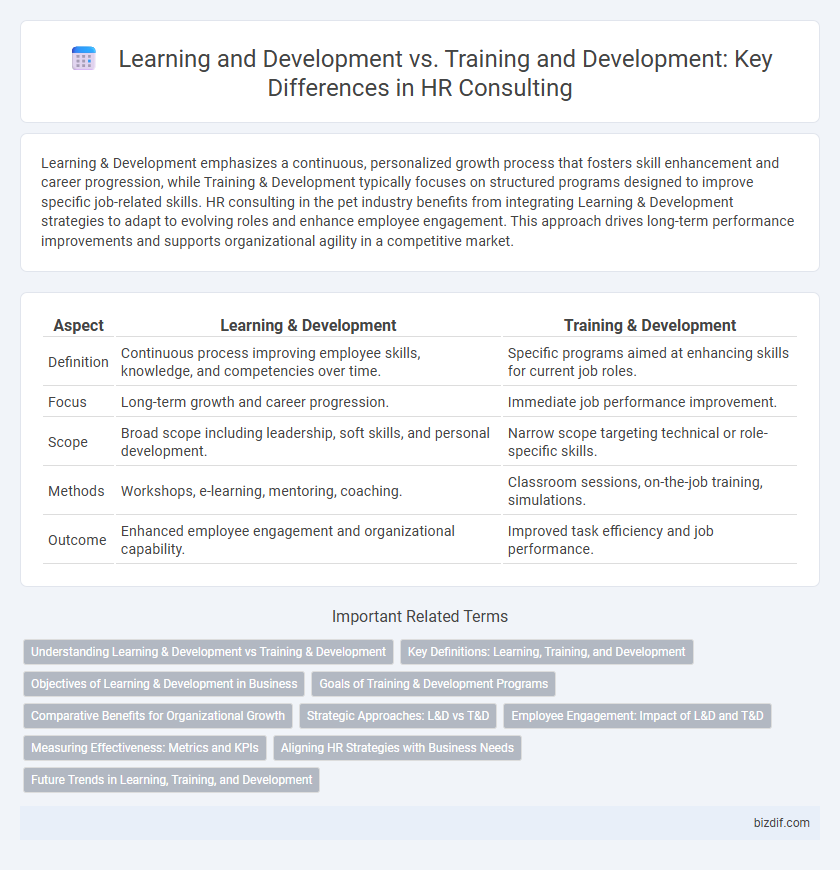Learning & Development emphasizes a continuous, personalized growth process that fosters skill enhancement and career progression, while Training & Development typically focuses on structured programs designed to improve specific job-related skills. HR consulting in the pet industry benefits from integrating Learning & Development strategies to adapt to evolving roles and enhance employee engagement. This approach drives long-term performance improvements and supports organizational agility in a competitive market.
Table of Comparison
| Aspect | Learning & Development | Training & Development |
|---|---|---|
| Definition | Continuous process improving employee skills, knowledge, and competencies over time. | Specific programs aimed at enhancing skills for current job roles. |
| Focus | Long-term growth and career progression. | Immediate job performance improvement. |
| Scope | Broad scope including leadership, soft skills, and personal development. | Narrow scope targeting technical or role-specific skills. |
| Methods | Workshops, e-learning, mentoring, coaching. | Classroom sessions, on-the-job training, simulations. |
| Outcome | Enhanced employee engagement and organizational capability. | Improved task efficiency and job performance. |
Understanding Learning & Development vs Training & Development
Learning & Development (L&D) encompasses a broad strategic approach to enhancing employees' skills, knowledge, and competencies for long-term growth, whereas Training & Development focuses on specific skill acquisition and performance improvement through structured programs. L&D integrates continuous, personalized learning paths aligned with organizational goals, emphasizing adaptability and innovation. Training & Development typically involves short-term, targeted sessions designed to address immediate job requirements and operational efficiency.
Key Definitions: Learning, Training, and Development
Learning in HR consulting refers to the continuous process through which employees acquire knowledge, skills, and competencies to enhance performance. Training involves structured programs designed to develop specific skills or behaviors necessary for immediate job tasks. Development encompasses broader, long-term growth initiatives aimed at preparing employees for future roles and leadership responsibilities.
Objectives of Learning & Development in Business
Learning & Development in business aims to enhance employees' skills, knowledge, and competencies to improve overall performance and drive organizational growth. It focuses on fostering continuous learning culture, aligning employee capabilities with strategic goals, and promoting adaptability in a dynamic market environment. This approach supports talent retention, leadership development, and innovation, making it a critical component of comprehensive human resource management.
Goals of Training & Development Programs
Training & Development programs aim to enhance employees' job-specific skills and competencies, ensuring immediate performance improvement and alignment with organizational objectives. These programs focus on measurable outcomes such as productivity, efficiency, and skill acquisition to meet current operational demands. Emphasizing continuous skill enhancement, they foster a workforce capable of adapting to evolving industry standards and business challenges.
Comparative Benefits for Organizational Growth
Learning & Development (L&D) emphasizes continuous employee skill enhancement and adaptive knowledge growth, fostering long-term organizational agility and innovation. Training & Development typically targets specific skill acquisition for immediate job performance improvement, resulting in quicker productivity gains. Organizations leveraging L&D benefit from sustained employee engagement and strategic capability building, while those prioritizing training see faster operational competency and task efficiency.
Strategic Approaches: L&D vs T&D
Learning & Development (L&D) centers on continuous skill enhancement aligned with long-term organizational goals, fostering a culture of innovation and adaptability. Training & Development (T&D) primarily addresses immediate skill gaps through structured programs aimed at improving job-specific competencies. Strategic approaches in L&D emphasize personalized learning paths and leadership growth, while T&D focuses on standardized modules to meet compliance and operational efficiency.
Employee Engagement: Impact of L&D and T&D
Learning & Development (L&D) emphasizes continuous skill enhancement and career growth, fostering higher employee engagement through personalized learning paths and competency development. Training & Development (T&D) primarily targets immediate job-related skills, leading to quick performance improvements but often with limited long-term engagement impact. Integrating L&D strategies with T&D initiatives boosts employee motivation, retention, and productivity by aligning organizational goals with individual aspirations.
Measuring Effectiveness: Metrics and KPIs
Learning & Development (L&D) effectiveness is measured through metrics like employee engagement, knowledge retention rates, and long-term behavioral changes. Training & Development (T&D) focuses on KPIs such as skill acquisition speed, course completion rates, and performance improvement immediately post-training. Both approaches benefit from combining qualitative feedback with quantitative data to assess impact on individual and organizational growth.
Aligning HR Strategies with Business Needs
Learning & Development (L&D) emphasizes continuous skill enhancement and knowledge acquisition aligned with evolving business objectives, driving long-term organizational growth. Training & Development (T&D) focuses on specific skills and competency improvement to meet immediate operational requirements. Aligning HR strategies with business needs involves integrating L&D initiatives to foster adaptability and innovation, ensuring workforce capabilities directly support strategic goals.
Future Trends in Learning, Training, and Development
Learning & Development (L&D) is evolving beyond traditional Training & Development by integrating personalized learning paths driven by artificial intelligence and data analytics to enhance employee skill acquisition and retention. Future trends emphasize continuous, on-demand microlearning modules, immersive technologies like virtual and augmented reality, and social learning platforms that foster collaboration and real-time feedback. Organizations investing in adaptive learning ecosystems see improved agility and innovation, positioning their workforce to meet rapidly changing market demands.
Learning & Development vs Training & Development Infographic

 bizdif.com
bizdif.com